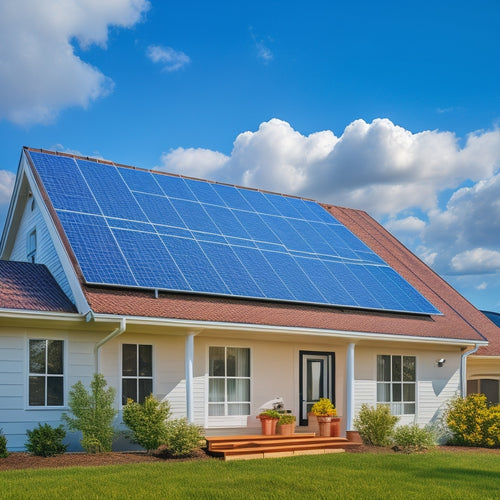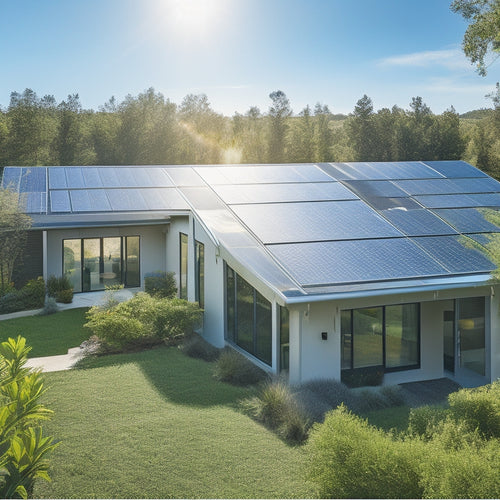
5 Best Portable Camping Lights for Outdoor Enthusiasts
Share
When choosing the best portable camping light for your outdoor excursions, consider a few key factors to guarantee safety and comfort. Look for energy-efficient designs with adjustable brightness settings to minimize power depletion. LED lights with color temperatures around 2700-3000K (warm white) and 3500-5000K (cool white) cater to different needs. Evaluating the battery life span of your portable light, and selecting the right battery type (rechargeable or disposable), will also make a difference. Additionally, check the water resistance rating (IPX) to ascertain your light functions in various camping conditions. Finding the right balance of these features will illuminate your path to the ideal portable camping light.
At a Glance
- Look for high lumens (200-400) and adjustable brightness for optimal camping visibility and energy efficiency.
- Consider compact and lightweight designs for easy portability and reduced storage space.
- Choose IPX-rated water-resistant lights for durability and reliability in outdoor environments.
- Energy-efficient designs with low power consumption rates and rechargeable batteries are ideal for extended camping trips.
- Select lights with multiple color temperature options (warm and cool white) for ambient and task-oriented lighting needs.
Increased Visibility at Night
When camping at night, you must take nighttime safety precautions to minimize the risk of accidents and injuries.
Illuminating dark areas around your campsite is essential to prevent tripping hazards and guarantee you can traverse safely.
Furthermore, reliable light sources enhance safety in remote areas, especially for families Safety and Reliability.
Nighttime Safety Precautions
| Safety Measure | Description | Benefits |
|---|---|---|
| Fire Pit or Ring | Contain the fire in a designated area | Prevents wildfires and reduces risk of burns |
| Fire Extinguisher | Quickly extinguish the fire in case of an emergency | Reduces risk of injury and property damage |
| Wildlife Awareness | Keep an eye out for wildlife attracted to food and light | Prevents encounters with wildlife and reduces risk of attack |
| Flashlights and Headlamps | Use reliable light sources to guide at night | Increases visibility and reduces risk of tripping or falling |
| Emergency Whistle | Signal for help in case of an emergency | Increases visibility and facilitates rescue |
Illuminating Dark Areas
Frequently, nighttime activities in the campsite can be challenging due to the lack of adequate lighting. A well-designed portable camping light can illuminate dark areas, making it easier for you to traverse your surroundings and perform tasks.
When choosing a camping light, consider the lumens and beam distance to guarantee it meets your needs. For example, a light with a higher lumen output can illuminate a larger area, making it ideal for tasks that require more visibility.
Portable camping lights also offer a more convenient alternative to traditional campfires. Campfire alternatives like battery-powered lanterns eliminate the need for firewood and minimize the risk of forest fires.
Some lantern features to look for include adjustable brightness, red light mode, and a USB charging port. Adjustable brightness allows you to customize the light output to your needs, while a red light mode helps preserve your night vision. A USB charging port makes it easy to recharge your light on the go.
Energy Efficiency Boosts Safety
When shopping for portable camping lights, you're likely looking for ways to minimize your environmental impact while also staying safe.
Reduced energy consumption is a key factor in achieving this balance, and many modern camping lights offer energy-efficient designs that help you conserve power.
By exploring low power alternatives, such as LED lights or rechargeable batteries, you can greatly lower your energy consumption and reduce the risk of accidents caused by depleted power sources.
Prioritizing energy efficiency leads to cost savings, reduced energy consumption, and a lower carbon footprint energy independence, making it an essential consideration for outdoor enthusiasts.
Reduced Energy Consumption
A camping light's energy efficiency can greatly reduce energy consumption, directly impacting safety on your camping trips. When you're out in the wilderness, the last thing you want is to be stuck without a reliable light source. By choosing a light that's energy-efficient, you can minimize the risk of running out of power when you need it most.
One way to achieve this is by opting for solar lighting. Many portable camping lights now come with solar panels that allow you to recharge your light during the day, so you can use it at night. This not only reduces energy consumption but also provides an eco-friendly option for campers.
When shopping for a portable camping light, look for energy-efficient features such as LED bulbs, which use considerably less power than traditional incandescent bulbs.
Additionally, consider lights with adjustable brightness settings, which allow you to customize your light output to suit your needs. By choosing an energy-efficient light, you can enjoy a safer and more sustainable camping experience.
Energy-efficient lights also tend to be more compact and lightweight, making them easier to carry on your excursions.
Low Power Alternatives
Low Power Alternatives
During nighttime excursions, you can enhance your safety considerably by opting for low-power alternatives that don't compromise on performance. By selecting the right portable camping light, you can minimize energy consumption and reduce the risk of accidents. This is particularly important when venturing into remote areas with limited access to power sources.
Low-power alternatives, such as solar powered and rechargeable options, have become increasingly popular among outdoor enthusiasts. These alternatives not only reduce energy consumption but also provide a reliable source of light when needed most.
| Feature | Description |
|---|---|
| Solar Powered | Harnesses sunlight to recharge batteries, eliminating the need for disposable batteries. |
| Rechargeable Options | Can be recharged via USB or wall adapter, reducing waste and minimizing environmental impact. |
| Energy Efficiency | Consumes minimal power while maintaining peak brightness, extending battery life. |
| Durability | Built with rugged materials to withstand harsh outdoor conditions, ensuring reliable performance. |
LED Light Color Temperature
When choosing a portable camping light, you'll encounter two primary LED light color temperatures: warm white and cool white.
Warm white lights, typically with a color temperature of 2700-3000K, emit a yellowish glow that's easier on the eyes and can create a cozy atmosphere, perfect for those moments when you're boondocking in remote areas and want to unwind off-grid solar power.
This freedom from reliance on commercial campsites allows you to fully immerse yourself in nature.
In contrast, cool white lights, usually with a color temperature of 3500-5000K, produce a brighter, bluer light that's better suited for tasks requiring higher visibility.
Warm White Lights
Switching to warm white lights can greatly impact your outdoor camping experience. When choosing an LED light, you'll often come across color temperatures measured in Kelvin (K). Warm white lights typically fall in the range of 2700K to 3000K, emitting a soft, yellowish glow. This color temperature is perfect for creating ambient lighting that's easy on the eyes and promotes relaxation.
In a camping setting, warm white lights can alter your outdoor space into a cozy retreat. They're perfect for illuminating your campsite, reading, or socializing with fellow campers. The warm tone also helps to reduce eye strain, making it easier to shift from daylight to nighttime activities.
When shopping for warm white lights, look for products with a color temperature of 2800K to 2900K for the best ambient lighting. Some portable camping lights may offer adjustable color temperatures, allowing you to switch between warm white and other color options.
Keep in mind that warm white lights may not be as bright as cooler options, but they provide a unique ambiance that can enhance your overall camping experience.
Cool White Lights
Cool white lights, typically measured in the 3500K to 5000K color temperature range, offer a crisp, neutral tone that's ideal for task-oriented activities.
When you're camping, you need a reliable light source to help you set up camp, cook meals, or perform repairs. Cool white lights provide the necessary illumination for these tasks, allowing you to work efficiently and effectively.
One of the key benefits of cool white lights is their ability to enhance visual acuity. The higher color temperature of these lights makes them perfect for reading, cooking, or performing tasks that require attention to detail.
Additionally, cool white lights are less likely to attract insects, reducing the nuisance of bugs while you're camping.
Cool white applications include camping, hiking, and backpacking. They're also ideal for use in workshops, garages, or other areas where task-oriented activities are common.
When choosing a portable camping light, consider the benefits of cool white lights and how they can enhance your outdoor experience. By selecting a light with the right color temperature, you can guarantee that you have the necessary illumination to stay safe and productive in the great outdoors.
Consider Battery Life Span
When choosing a portable camping light, you'll want to take into account the battery life span, which is heavily influenced by power consumption rates and the type of battery used.
Different lights have varying power consumption rates, measured in watts or lumens per watt, which can greatly impact battery life. The capacity and output power of solar battery backup systems, such as the Goal Zero Yeti 1000 Solar Kit, can also impact the overall battery life span.
By evaluating the battery type options, such as alkaline, nickel-cadmium (Ni-Cd), or lithium-ion (Li-ion), you can better understand their impact on the overall battery life span of your portable camping light.
Additionally, advanced tech features like MPPT charge controllers and remote monitoring can also play a role in optimizing energy management and battery life.
Power Consumption Rates
Your portable camping light's power consumption rate directly affects its battery life span. As you consider the best portable camping light for your needs, it's crucial to understand how power consumption rates impact your overall camping experience. Power consumption is usually measured in watts (W) or lumens per watt (lm/W), which indicates the light's efficiency.
When evaluating power consumption rates, you should also consider the light's charging options. Some portable camping lights come with USB charging, while others offer solar power, which is ideal for extended camping trips or for those who prefer a more sustainable option.
If you plan to use your portable camping light for an extended period, look for one with a low power consumption rate to minimize battery drain. A lower power consumption rate can also lead to reduced heat generation, making the light more comfortable to handle and reducing the risk of overheating.
Battery Type Options
Selecting the right battery type for your portable camping light can greatly impact its overall performance and battery life span. You'll typically have two options: rechargeable batteries and disposable batteries.
Rechargeable batteries, such as nickel-metal hydride (NiMH) or lithium-ion (Li-ion), offer a cost-effective solution in the long run. They can be reused multiple times, reducing waste and saving you money on replacement batteries. However, their initial cost is often higher than disposable batteries.
Disposable batteries, such as alkaline or zinc-carbon, are convenient for short camping trips or emergency situations. They're often less expensive upfront, but they can't be reused, and their performance may degrade over time.
When choosing between rechargeable and disposable batteries, consider your camping frequency and the light's power consumption rate. If you're a frequent camper, rechargeable batteries might be the better option. On the other hand, disposable batteries might be suitable for occasional use.
Assessing the pros and cons of each will help you make an informed decision and guarantee your portable camping light performs at its best. Consider the battery life span and choose the type that best fits your outdoor needs.
Water Resistance Key Advantage
When you're shopping for a portable camping light, you'll often see a rating that indicates its water resistance, usually in the form of IPX followed by a number.
These ratings are standardized by the International Electrotechnical Commission (IEC) to help you understand a light's ability to withstand water and moisture.
IPX Ratings Explained
Camping in the great outdoors often means dealing with unpredictable weather. When choosing a portable camping light, it is crucial to take into account its water resistance to guarantee it can withstand various camping conditions. IPX ratings are a key factor in determining a light's outdoor durability.
IPX ratings are a set of waterproof standards that measure a product's resistance to solid particles and water. The ratings consist of two digits, with the first digit representing protection against solid particles and the second digit representing protection against water.
| IPX Rating | Solid Particle Protection | Water Protection |
|---|---|---|
| IPX0 | No protection | No protection |
| IPX4 | Protection against splashing | Protection against splashing |
| IPX7 | Protection against dust | Protection against immersion up to 1 meter |
| IPX8 | Protection against dust | Protection against immersion beyond 1 meter |
When researching portable camping lights, look for IPX ratings in user reviews and product comparisons. A higher IPX rating generally indicates better waterproofing and outdoor durability. By evaluating IPX ratings, you can ascertain your light remains functional in various camping conditions, and with proper maintenance, it will continue to provide reliable light intensity for years to come.
Frequently Asked Questions
Can Portable Camping Lights Be Used in Extreme Cold Weather?
You'll find some portable lights can withstand extreme cold, but you'll need to take into account battery performance and light durability. Look for LED lights with cold-resistant batteries and durable casings to guarantee reliable illumination in freezing temperatures.
How Often Should Camping Lights Be Inspected for Damage?
You inspect your camping lights regularly to guarantee they're in good working condition, taking necessary safety precautions to avoid electrical shock. Regular light maintenance helps prevent accidents and assures reliable illumination during your outdoor escapades.
Do Portable Camping Lights Interfere With Wildlife at Night?
Like a guiding light in the dark, your outdoor escapades can have unintended effects. You may inadvertently disrupt wildlife behavior, especially at night, as portable lights contribute to light pollution, altering nocturnal habitats and patterns.
Can I Use Rechargeable Batteries in Camping Lights?
You can use rechargeable batteries in camping lights, but check compatibility first. Look for lights that accept NiMH or Li-ion rechargeable battery types, and make certain the light's voltage and capacity requirements match your rechargeable batteries' specs.
Are Portable Camping Lights Allowed in All National Parks?
Imagine camping under starry skies in a national park. You'll need to check park regulations beforehand, as not all portable lighting types are allowed; some parks restrict battery-powered or LED lights, so plan accordingly.
Explore More
Now that you're equipped with the essentials for choosing the best portable camping lights, it's time to shine a light on your next expedition. Don't let the darkness 'pull the plug' on your fun – opt for energy-efficient, water-resistant LEDs that'll keep you safe and visible. With the right portable light, you'll be 'illuminating' the great outdoors in no time, and creating memories that'll last a lifetime – sans the darkness.
Related Posts
-

Cost of Solar Panel Installation
You can expect to pay between $15,000 and $30,000 or more for a typical solar panel installation, depending on the sy...
-

Smart Grid Technology Implementation Challenges
You'll encounter several challenges when implementing smart grid technology, particularly in cost management, scalabi...
-

Installing Metal Solar Roofs for Maximum Energy Efficiency
Installing metal solar roofs can drastically enhance your home's energy efficiency and durability. These roofs withst...


